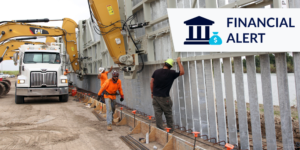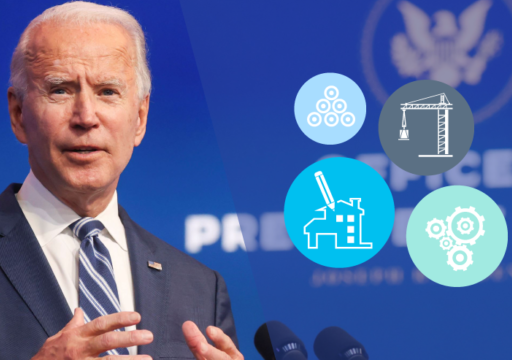
After President Biden’s January 20, 2021, proclamation terminating the redirection of billions in government funding to what was derided as an “ineffective and damaging border wall” between the US and Mexico, the White House reaffirmed in a statement on June 11, 2021, that the Department of Homeland Security and Department of Defense are canceling all border wall projects and returning remaining funds to their “original purposes.”
The Biden administration’s press release notes that it will continue to work at former border construction sites in order to address “safety and environmental issues resulting from border wall construction under the previous Administration.”
In total, the announcement details that nearly $2.2 billion in funds will be returned to their original sources.
A June 10, 2021, memorandum from Deputy Secretary of Defense Kathleen Hicks notes the specificities of the Department of Defense’s plan. “…the Department will use the $2.2 billion of available unobligated military construction appropriations to restore funding for 66 projects in 11 States, 3 territories, and 16 countries in [fiscal year] 2021.”
Of the total funds, $299 million will go to state projects in Alaska, Florida, Indiana, Maryland, North Carolina, South Carolina, Texas, Utah, Virginia, Washington, and Wisconsin. $608 million will be used for projects in the US territories of Guam, Puerto Rico, and the Virgin Islands.
Learn more: The Difference Between Public and Private Projects
The White House’s statement highlights a number of domestic projects that will “restore funds for [military base] schools, hangars, housing, and essential operational and training facilities.”
The plan includes $10 million for the “Missile Field Expansion” at Fort Greely, Alaska — part of the U.S. defenses “against North Korean ballistic missiles” — as well as $25 million for the second “Radio Battalion Complex” in North Carolina intended to “meet the growing threat of cyber warfare,” and more than $25 million for the “Fire/Crash Rescue Station” at Tyndall Air Force Base in Florida, a complex designed to “support up to 15 fire-fighting vehicles and provide space for physical fitness, training, and living quarters for military personnel.”
In addition to these amounts, $1.3 billion will be returned to military projects on overseas bases — including the similarly controversial Guantanamo Bay prison facility in Cuba, a facility which President Biden recently announced his intention to close by the end of his first term in office.
Other overseas projects include a $79 million package for the Spangdahlem Elementary School for US Military Children in Germany, a school which “currently supports over 600 military children, lacks proper air conditioning, plumbing, and security systems and was due for replacement when the prior Administration diverted funds to the wall.”
Funding may be turned around elsewhere, as well. In its press release, the White House added that “the Administration is reiterating its call for Congress to cancel funds it previously appropriated for border barrier projects so that these resources can instead be used for modern, effective border management measures to improve safety and security.”

11 Ways President Biden Plans To Impact Construction
Environmental concerns may keep activity on areas of border wall construction, require continued focus from contractors
The previous construction of the border wall resulted in a significant number of environmental concerns — even while border wall funds are being returned to their original purposes, the Biden administration claims it will maintain its focus on addressing environmental and safety issues.
In the White House’s press release, it added that the “DHS is announcing today that it will prioritize the remaining border barrier funds to address urgent life, safety, and environmental issues resulting from the previous Administration’s wall construction.”
“For instance, DHS has already started work to repair the Rio Grande Valley flood protection system that the prior Administration compromised, and to remediate dangerous soil erosion due to improper soil compaction along a 14-mile wall segment in San Diego, California,” the White House statement notes. Both issues were first addressed by the Department of Homeland Security in May 2021.
According to the DHS, contractors “blew large holes” in the levees that act as part of the Rio Grande Valley flood protection system.
“These were not little holes,” said Hidalgo County Public Affairs Division Director Carlos Sanchez of the damage done to the levees. “These were road-sized breaches — and there were at least four of them.”
“When Biden ordered the halt to construction, basically all the contractors sent their workers home. There was no construction happening…Technically, they were arguing that they were no longer having to fulfill the conditions of the contract, which stated you have to fill this breach within 48 hours.”
Contractors in the Rio Grande valley have already started to repair the damage done, and considerable work remains as a focus of the local government, who hope the Biden administration will work with similar urgency.
“There is a long history of worry and efforts to maintain this levee system,” Sanchez said. “If the levee system is weakened, the potential of the levee itself collapsing or being breached by floodwaters is very real. And I think that is the overriding concern…There’s a variety of ways for flooding to hit this region, but the ultimate impact is massive flooding.”
Border wall construction may not be finished on a state level, as Texas Republicans push for further work
Despite the Biden administration’s re-focusing of border wall funding, some Republican lawmakers are focused on continuing the border wall’s construction at a state level, leaving the opportunity open for contractors to once again be involved in major construction along the US-Mexico border.
On June 16, 2021, Texas Governor Greg Abbott announced that the state was planning to build its own wall between Texas and Mexico, claiming “Texas will build a border wall in our state to help secure our border” — starting with hiring a program manager and directing $250 million state funds as a “down payment” for the project.
Abbott directed the Texas Facilities Commission to hire a program manager and begin work. Lawmakers plan to allocate money for the project from the Texas Department of Criminal Justice.
Jeremy Desel, a spokesman for the Texas Department of Criminal Justice, added that the money would be ready for allocation soon, and that “the money will be reappropriated without a negative impact on TDCJ.”
Though the Trump administration had previously faced pushback from private landowners who were unwilling to have border construction on their land, Abbott claims that he expects Texas residents to donate both money and land to the project. ”My belief based upon conversations that I’ve already had is that the combination of state land as well as volunteer land will yield hundreds of miles to build a border wall in Texas,” he noted.
Abbott is likely to face significant resistance from opposition lawmakers, making the wall far from guaranteed as he acknowledged that it would cost “far more than $250 million.”
“Building a wall from El Paso to Brownsville is the most expensive and least effective way to do border security and it’s a huge waste of taxpayer money,” said Texas Senator Cesar Blanco about the project.
If the project moves forward, it could put significant funds back into construction.
The federal government previously noted that building some sections of the border wall in Texas cost $26.5 million per mile, while the Biden administration’s June 11, 2021, release noted that some portions of the wall cost $46 million per mile.
Read more: How to Minimize Risk on Government Construction Projects